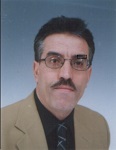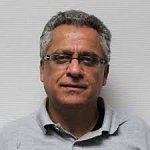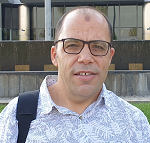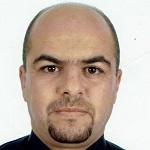|

Pr. Aissa AIBECHE
TO DOWNLOAD HIS MINI-CV
|
Professor at Ferhat ABBAS Setif University, Algeria
Research Interests
Non-classical boundary value problems for elliptic differential equations, coerciveness, completeness of generalized eigenvectors. Linear elliptic partial differential equations in non-smooth domains, singular solutions.
Scientific work at last ten years
Publications
A Aibeche, W Chikouche, Y Daikh, Real interpolation spaces between the domain of the laplace operator with transmission conditions and Lp on a polygonal domain, Electronic Journal of Differential Equations 2012 (10), 1-14, 2012
A Aibeche, N Amroune, S Maingot, On elliptic equations with general non-local boundary conditions in UMD spaces, Mediterranean Journal of Mathematics 13 (3), 1051-1063, 2016
A Aibeche, S Hadi, A Sengouga, Asymptotic behaviour of nonlinear wave equations in a noncylindrical domain becoming unbounded, Electronic Journal of Differential Equations, Vol. (2017), No. 288, pp. 1–15. 2017
A Aibeche, N Amroune, S Maingot, General non local boundary value problem for second order elliptic equation, Mathematische Nachrichten 291 (10), 1470-1485, 2018
|
|
TRACE'S IN SOBOLEW SPACES ON LIPSCHITZIAN DOMAINS IN R2
In this talk we, first we will give an application, of the famous result of Geymonat and al [3], to the biharmonic problem in lipschitzian domains in R2. After this, using a theory of potential tensor which is an extension of the theory of potential vector introduced by Amrouche and al [2], we will characterize the image of trace’s operator in sobolev space W3,p(Ω) where Ω is a lipschitzian domain in R2.
This talk is based on the following paper [1] and it is done in collaboration with C. Amrouche (Univ-. Pau) and B. Bahouli (ENS, Constantine).
References
[1] A. Aibeche, C. Amrouche and B. Bahouli, Trace Operator’s Range Characterization for Sobolev Spaces on Lipschitz Domains of R2. To appear in Comptes Rendus Mathématiques, Académie des Sciences, Paris.
[2] C. Amrouche and NEH. Selloula, Lp-theory for vector potentials and Sobolev’s inequalities for vector fields: application to the Stokes equations with pressure boundary conditions, Math. Models Methods Appl. Sci. 23 1, (2013), p.37–92.
[3] G. Geymonat and F. Karsucki, On the existence of the Airy function in Lipschitz domains. Application to the traces of H2. CRAS, 330 5, (2000), p. 335–360.
|
|

Pr. Noureddine BENHAMIDOUCHE
TO DOWNLOAD HIS MINI-CV
|
Professeur à l'Université de M'sila - Algérie
Domaine de spécialisation :
- Analyse d'EDPS non linéaires.
- Applications en traitement d'image et en biologie.
Diverses taches:
Conseiller auprès du MESRS (Ministère délégué à la recherche) Janvier 2003 - Juin 2004, chargé de plusieurs dossiers ,
Coordonnateur de la commission nationale des NTIC MESRS. Fév 2003 - Juin 2004.
Président de la Commission Pédagogique National du domaine MI (CPND-MESRS), 2016-2017.
Directeur du laboratoire de Mathématiques pures et appliquées, Depuis Mars 2014 à ce jour.
|
|
LA MODELISATION MATHEMATIQUE AU SERVICE DU DEVELOPPEMENT TECHNOLOGIQUE
Le but de l'expose est de mettre en exergue le rôle des mathématiques dans le développement technologique et dans les nouvelles tendances de l'économie du savoir à travers le monde via l'outil de la modélisation.
On va parler notamment de :
- La technique de modélisation mathématique et son impact.
- Une illustration des différentes applications des mathématiques dans divers domaines technologiques.
- De la question : Y'a-t-il de frontière entre « maths pures » et « Maths appliquées » ?
|
|

Pr Adnan YASSINE
TO DOWNLOAD HIS MINI-CV
|
Professeur à l'Université Le Havre Normandie. Professeur Classe Exceptionnelle depuis septembre 2015.
ACTIVITES SCIENTIFIQUES
Encadrement de 32 thèses de doctorat (30 thèses déjà soutenues et 2 en cours).
Participation à 68 jurys de thèses et HDR (dont 10 en tant que président et 27 en tant que rapporteur).
68 publications dans des revues internationales spécialisées avec comité de lecture.
7 conférences plénières (conférencier invité).
115 conférences internationales, 29 conférences nationales, 22 séminaires et journées thématiques.
1 chapitre d'ouvrage.
ENSEIGNEMENTS
Optimisation non linéaire - Optimisation combinatoire - Recherche Opérationnelle - Théorie des graphes - Analyse numérique - Outils mathématiques pour l'ingénieur - Analyse mathématique.
THÈMES DE RECHERCHE
- Optimisation (convexe, non convexe, différentiable, non différentiable, globale, DC).
- Optimisation combinatoire - Recherche Opérationnelle.
- Applications sur des problèmes réels : dimensionnement et gestion de plateformes multimodales,
transport collectif et à la demande, tournées de véhicules, stockage et entreposage, ordonnancement,
optimisation de flux, gestion des terminaux portuaires, écologie industrielle.
|
|
MODELES MATHEMATIQUES EN ECOLOGIE INDUSTRIELLE
L'écologie industrielle est une approche novatrice (R. Frosch et N. Gallopoulos, 1989) qui cherche une amélioration continue de l'ensemble des processus de production en représentant un système industriel comme un écosystème et à le rendre très proche des écosystèmes naturels. Son objectif est de minimiser les pertes de matières dans les processus de consommation et de production et limiter les impacts de l'industrie sur l'environnement en minimiser l'émission de CO2 et les gaz à effet de serre. Elle peut être considérée comme :
- La résolution de l'utilisation des ressources dans les sociétés technologiques.
- La réponse de l'industrie au développement durable.
Le concept d'écologie industrielle peut être réalisé et pratiqué à travers l'étude et la promotion de la symbiose industrielle et l'établissement des parcs éco-industriels. Un parc éco-industriel est une communauté de fabrication et de service des entreprises regroupées ensemble sur une propriété commune. Les membres cherchent la performance environnementale, économique et sociale accrue grâce à la collaboration dans la gestion des questions environnementales et de ressource et les échanges spontanés des produits (déchets, eau, énergie). Dans ce travail, nous proposons différents modèles mathématiques qui rentrent parfaitement dans le cadre de l'économie circulaire et le développement durable en maximisant les échanges des flux dans un parc éco-industriel et réduire les impacts négatifs sur l'environnement tout en garantissant les performances économiques du parc. Nous présenterons des résultats numériques des modèles mathématiques développés.
|
|

Dr. Aissa GUESMIA
TO DOWNLOAD HIS MINI-CV
TO DOWNLOAD HIS PUBLIATIONS
|
Maitre de Conferences à l'Universite de Lorraine - Metz, France(habilite depuis 31/10/2006, et hors classe depuis 01/09/2022) (section 26).
DOMAINES DE COMPETENCE ET D'INTERET
Analyse non lineaire.
Equations aux derivees partielles.
Stabilite de solutions. Theorie du controle. Analyse numerique
THEMES DE RECHERCHE
Inegalites integrales et/ou dierentielles et methode de multiplicateurs.
Existence, unicite et regularite de solution des EDPs.
Comportement asymptotique de solutions de systemes distribues (avec damping memoire, retard,...).
Observabilite et controlabilite exacte des systemes d'evolution.
Web : iecl.univ-lorraine.fr/membre-enseignant/guesmia-aissa/
|
|
CAUCHY SYSTEMS OF TYPE RAO-NAKRA SANDWICH BEAM WITH FRICTIONAL DAMPINGS OR INFINITE MEMORIES: SOME Lq(R)-NORM POLYNOMIAL STABILITY ESTIMATES
The objective of this work is to study the stability of two systems of type Rao-Nakra sandwich beam in the whole line R with a frictional damping or an innite memory acting on the Euler-Bernoulli equation. When the speeds of propagation of the
two wave equations are equal, we show that the solutions do not converge to zero when time goes to innity. In the reverse situation, we prove some L2(R)-norm and L1(R)- norm decay estimates of solutions and theirs higher order derivatives with respect to the space variable.
Thanks to interpolation inequalities and Carlson inequality, these L2(R)-norm and L1(R)-norm decay estimates lead to similar ones in the Lq(R)-norm, for any q 2 [1;+1]. In our both L2(R)-norm and L1(R)-norm decay estimates, we
specify the decay rates in terms of the regularity of the initial data and the nature of the control. Applications to some Cauchy Timoshenko type systems will be also given. The proof is based on the energy method combined with the Fourier analysis (by using the transformation in the Fourier space and well chosen multipliers).
A part of these results was obtained in collaboration with Salim Messaoudi (University of Sharjah, UAE).
For the details, see the following paper:
A. Guesmia, Some Lq(R)-norm decay estimates (q 2 [1;+1]) for two Cauchy systems of type Rao-Nakra sandwich beam with a frictional damping or an innite memory, J.Appl. Anal. Comp., 12 (2022), 1-30.
|
|

Dr Ali KHALOUTA
TO DOWNLOAD HIS MINI-CV
|
Maître de Conférences Classe « A » Enseignant Chercheur Département de Mathématiques, Faculté des Sciences, Université Ferhat ABBAS Sétif 1, Algérie.
EXPERIENCES PROFESSIONNELLES & ACADÉMIQUES :
- 2010 à ce jour : Enseignant permanent à l'Université Ferhat ABBAS Sétif 1.
- 2016 à ce jour : Adjoint chef du département de Mathématiques chargé des études et des questions liées aux étudiants.
ACTIVITES PEDAGOGIQUE ET SCIENTIFIQUE :
- 2016 à ce jour : Membre du comité scientifique du département de Mathématiques.
- 2018-2020 : Membre du conseil de discipline du département de Mathématiques.
- 2019 à ce jour : Membre du Laboratoire de Mathématiques Fondamentales et Numériques (LMFN), Université Ferhat ABBAS Sétif 1.
- 2020 : Formation sur la plateforme en ligne « Moodle ».
|
|
A NEW GENERAL INTEGRAL TRANSFORM AND ITS APPLICATIONS
Today, differential equations play an important role in many fields of science, as they are used in the mathematical modeling of many problems in applied mathematics and engineering sciences, such as dynamical systems, signal processing, physical chemistry, mathematical biology, probability and statistics, fluid mechanics, elasticity, electrostatics, electrodynamics, etc. Therefore, there have been many attempts to develop new techniques for solving differential equations.
Over the past two centuries, integral transforms have been used effectively to solve many problems in science and engineering. In particular, to solve differential equations such as: ordinary differential equations, integro-differential equations and partial differential equations, integral transforms are widely used and much research work is carried out on their theory and applications.
The main objective of this talk is to introduce a new general integral transform which is a generalization of many well-known integral transforms. We discuss the useful properties of this integral transform and its applications to solve differential equations. Finally, we ensure the efficiency and accuracy of the proposed integral transform by solving various examples of ordinary, integro and partial differential equations.
REFERENCES
[1] R.N. Bracewell, The Fourier transform and its applications, (3rd ed.). McGraw-Hill, New York, (1999).
[2] D. Donolato, Analytical and numerical inversion of the Laplace-Carson transform by a differential method, Computer Physics Communications, 145(2), 298-309 (2002).
[3] F.B.M. Belgacem and A.A. Karaballi, Sumudu transform fundamental properties, investigations and applications, Journal of Applied Mathematics and Stochastic Analysis, Article ID 91083, 1-23 (2006).
[4] Z.U.A. Zafar, ZZ Transform Method, International Journal of Advanced Engineering and Global Technology, 4, 1605-1611 (2016).
[5] Z.M. Alwan, (ZMA)-transform method, Journal of Interdisciplinary Mathematics, 24(7), 1841-1849 (2021).
[6] T.M. Elzaki, The New Integral Transform "Elzaki Transform", Global Journal of Pure and Applied Mathematics, 7(1), 57-64 (2011).
[7] K.S. Aboodh, The New Integral Transform "Aboodh Transform", Global Journal of Pure and Applied Mathematics, 9(1), 35-43 (2013).
[8] F.B.M. Belgacem and R. Silambarasan, Theory of natural transform, Mathematics in Engineering, Science and Aerospace, 3(1), 105-135 (2012).2020 Mathematics Subject Classification: 34A37, 44A05, 45E10.
Key words and Phrases: general integral transform, Fourier transform, differential equations, exact solutions.
Key words and Phrases: general integral transform, Fourier transform, differential equations, exact solutions.
|






